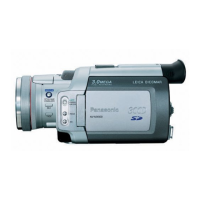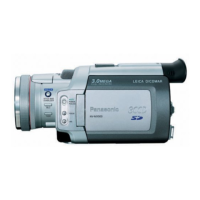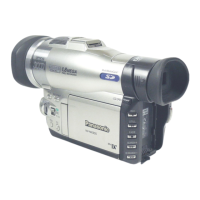Do you have a question about the Panasonic NV-MX2 and is the answer not in the manual?
Essential safety guidelines for operating the movie camera and its accessories.
Safety precautions and proper handling of the AC power cord and plug.
Step-by-step instructions for safely replacing the fuse in the power plug.
Introduction to the card mode for recording and playback functions.
Introduction to the camera mode for recording video.
Introduction to the VCR mode for playback and tape operations.
Components supplied with the movie camera for basic operation.
Optional accessories for enhanced video and audio capabilities.
Optional accessories for power, data transfer, and system expansion.
Charging the battery and inserting a video cassette.
Turning the camera on and initiating the recording process.
Procedure for playing back recorded footage from the cassette.
LCD monitor, viewfinder, and smart accessory shoe overview.
Key buttons for mode selection, effects, and menu navigation.
Controls related to the lens and the main operation lever.
Information on tripod mount, sensors, and microphone placement.
Identification of buttons on the remote for camera operation.
Instructions for inserting the battery into the remote control.
Guidelines for using the remote and selecting operating modes.
Connecting the AC adapter and charging/using the battery.
Using the car charger and understanding charging/recording times.
Attaching protective and carrying accessories.
Loading a video cassette and preventing accidental erasure.
Procedures for powering the camera on, off, and switching modes.
Adjusting the viewfinder and LCD monitor for optimal viewing.
Customizing display brightness and color saturation.
Steps for selecting, adjusting, and exiting menu items.
Selecting files for operations within the card playback mode (NV-MX8).
Overview of camera setup, digital effects, card, recording, and display menus.
Overview of VCR playback, effects, card, recording, and AV setup menus.
Menus for display settings, remote control, and demo modes.
Menu options for recording, AV input/output, display, and other functions.
Options for erasing, locking, and formatting card files.
Quick access menus for slide shows, file searches, and DPOF settings.
Configuring the camera's clock and recharging the internal battery.
Details on LP recording mode and audio recording quality options.
Procedures for initiating, pausing, and stopping the recording process.
Understanding the tally lamp and checking recorded footage during pause.
Tips for self-recording and using camera search during playback.
Details on Photoshot, Progressive, Continuous, and Digital Still Picture.
Using the zoom lever and macro focus capabilities.
Utilizing the zoom microphone for directional sound recording.
Expanding zoom range beyond optical limits for close-ups.
Correcting camera shake for stable footage.
Recording in widescreen format and improving exposure in backlit scenes.
Selecting automatic exposure modes for various conditions.
Using auto white balance and manually adjusting for precise color control.
Location of the sensor and examples of lighting conditions affecting white balance.
Adjusting shutter speed for fast-moving subjects.
Adjusting aperture for brightness control.
Manually focusing for difficult subjects.
Reducing wind noise picked up by the microphone.
Using the built-in flash, adjusting brightness, and reducing red-eye.
List and description of available digital effects.
Creating transitions between scenes using wipe and mix effects.
Displaying a smaller picture within the main screen.
Capturing sequences of still images in various modes.
Deleting or re-displaying captured multi-picture sequences.
How to begin, pause, stop playback, and control audio volume.
Navigating tape using cue, review, and variable speed search.
Playing back at slow speeds or frame-by-frame.
Advancing playback frame-by-frame and finding the end of recordings.
Locating recorded scenes using index signals.
Enlarging parts of the image during playback.
Selecting and applying various digital effects.
Using wipe and mix effects during playback.
Playing back strobe, manual, and index multi-pictures.
Deleting, re-displaying, or cancelling multi-picture captures.
Locating specific pictures within a multi-picture display.
Connecting the camera to a TV for viewing recorded content.
Adding narration or music to recorded audio tracks.
Copying footage to external VCRs.
Inputting and recording content from external sources.
Performing digital dubbing using a DV cable.
Automatically printing selected still pictures.
Using kits for transferring still pictures to a PC.
Procedures for inserting and removing cards and understanding the access lamp.
Details on recording still pictures (Photoshot) onto a card.
Adjusting image quality for card photoshoots.
Automatically copying still pictures from tape to the card.
Capturing video files in MPEG4 format.
Recording audio files onto the memory card.
Viewing individual still images or starting a slide show.
Playing back recorded MPEG4 video and voice data.
Controlling the audio volume during playback.
Navigating and selecting files for playback.
Activating and using the file search feature.
Transferring one still picture at a time.
Automating the process of copying all pictures.
Initiating, controlling, and pausing slide show playback.
Customizing slideshows by selecting, ordering, deleting, and verifying pictures.
Function to create and record custom titles.
Applying existing titles to pictures.
Locking files to prevent accidental erasure.
Erasing specific files or titles from the card.
Erasing all files from the card based on mode.
Setting print quantities for images using DPOF.
Making a card reusable by erasing all data.
Indicators for battery status, tape time, and card access.
Indicators for camera modes, effects, and specific functions.
Indicators related to memory card status and image dimensions.
Registering personal information and understanding warning indications.
Notes on battery, AC adapter, and cassette insertion/removal.
Advice on recording, checking footage, and camera search.
Specific notes on photoshot modes and progressive settings.
Hints regarding zoom, image stabilization, and cinema mode.
Specific advice on white balance and shutter speed adjustments.
Tips for using the video flash effectively.
Usage notes for digital effects and PiP mode.
Tips for multi-picture playback and index searches.
Notes on playback zoom, headphone use, and TV output.
Usage notes for audio dubbing and recording from other devices.
Notes on digital dubbing via DV cable and automatic printing.
Limitations and notes specific to card recording.
Notes on card playback, creating titles, and file protection.
Precautions when using the memory card with a personal computer.
Explanation of the folder structure when using a card with a PC.
Important precautions regarding water, magnetism, and chemicals.
Steps to take when condensation affects camera operation.
How to clean video heads to ensure proper playback.
Information on battery performance, charging, and handling.
Guidelines for storing the camera, battery, cassette, and accessories.
Notes on using and caring for displays and lens accessories.
Troubleshooting problems with editing, dubbing, and LP mode.
Resolving issues with time code, tape time, image playback, and sound.
Troubleshooting sound playback and problems with memory cards.
Explanations of terms, focus, and white balance adjustments.
Setting tape positions for quick playback or editing.
Using memory stop to automate audio dubbing.
Technical details of the camera's hardware and recording capabilities.
Technical data for the power adapter and memory card functions.











